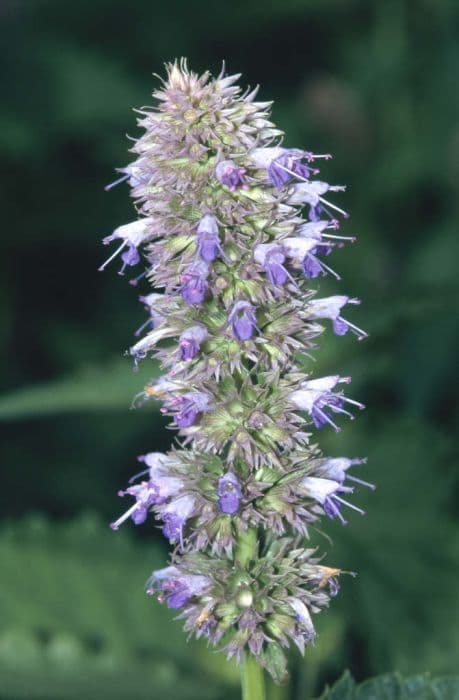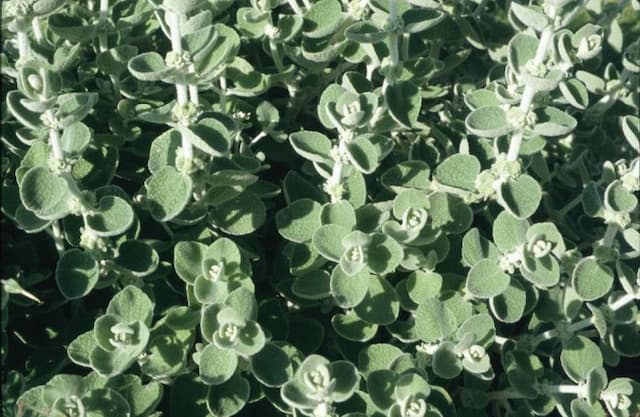Rosemary Salvia rosmarinus 'Foxtail' (Ro)

ABOUT
Salvia rosmarinus 'Foxtail', commonly known as rosemary, is a perennial herb with distinct features that set the 'Foxtail' variety apart from the classic rosemary plant. This variety is named for its unique branching that resembles the tail of a fox. Its leaves are narrow and needle-like, boasting a rich green color that adds a vibrant splash of evergreen to any setting. The foliage of the rosemary 'Foxtail' is aromatic, releasing a pungent and refreshing scent reminiscent of pine when brushed or crushed. This aroma makes it a favorite not only in gardens but also in culinary uses. Small, tubular flowers bloom on the plant, typically presenting shades of blue which can be quite pronounced and add an ornamental quality to the herb. These flowers are beloved by pollinators and can provide visual interest in the landscape throughout their blooming season. As a member of the mint family, the stems of the 'Foxtail' rosemary are square in cross-section, though this may not be immediately obvious due to the dense growth of the leaves. The growth habit of this particular variety tends to form a thick, somewhat upright and waving mass of foliage, giving the impression of movement and adding a textural element to its surroundings. Hardy and resilient, 'Foxtail' rosemary has a preference for sunny conditions and well-draining soil, making it a suitable choice for a variety of garden settings where its visually appealing form and inviting fragrance can be thoroughly enjoyed.
About this plant
 Names
NamesFamily
Lamiaceae.
Synonyms
Foxtail Rosemary, Cascading Rosemary, Weeping Rosemary.
Common names
Rosmarinus officinalis, Rosmarinus officinalis 'Prostratus', Rosmarinus officinalis var. prostratus.
 Toxicity
ToxicityTo humans
Rosemary is generally not toxic to humans when consumed in typical culinary quantities. Ingesting large amounts of the plant could potentially lead to gastrointestinal discomfort or other adverse effects due to the potent essential oils it contains. Nonetheless, rosemary is widely used as a flavoring herb, and significant toxicity in humans is rare.
To pets
Rosemary is considered non-toxic to pets, including dogs and cats. It can often be found in natural pet foods as a flavor enhancer and preservative. However, as with any non-typical food item, consuming large amounts may cause mild gastrointestinal upset in some animals. Overall, it is not regarded as a poisonous plant for pets.
 Characteristics
CharacteristicsLife cycle
Perennials
Foliage type
Evergreen
Color of leaves
Green
Flower color
Blue
Height
4-6 feet (1.2-1.8 meters)
Spread
2-4 feet (0.6-1.2 meters)
Plant type
Shrub
Hardiness zones
8
Native area
Mediterranean
Benefits
 General Benefits
General Benefits- Culinary uses: Rosemary is a popular herb in cooking, known for its fragrant aroma and flavor that complements a variety of dishes such as meats, breads, and soups.
- Aromatic: The plant emits a pleasant scent that can enhance the sensory appeal of gardens and indoor spaces.
- Ornamental value: 'Foxtail' has a unique branching pattern that resembles a fox's tail, adding visual interest to landscaping and gardens.
- Drought tolerance: Rosemary is well-adapted to dry conditions, requiring minimal watering once established, which makes it a suitable plant for xeriscaping and water-wise gardening.
- Low maintenance: This plant typically requires little care, being resistant to many pests and diseases, and can thrive with minimal pruning and fertilizing.
- Attracts pollinators: Rosemary flowers can attract bees and other beneficial insects, promoting pollinator health and biodiversity in the garden.
- Culinary versatility: Rosemary can be used fresh, dried, or as an infused oil, offering a range of applications for both home cooks and professional chefs.
 Medical Properties
Medical Properties- Antioxidant: Contains compounds that may help in protecting cells from damage caused by free radicals.
- Anti-inflammatory: May help reduce inflammation in the body due to certain active constituents like rosmarinic acid.
- Antimicrobial: Exhibits properties that can help to fight against certain bacteria, fungi, and viruses.
- Memory and concentration: Traditionally associated with cognitive enhancement, potentially improving memory and concentration.
- Digestive health: Often used to alleviate digestive issues like bloating or indigestion.
- Hair growth: Topically applied rosemary oil is sometimes used to help stimulate hair follicles and promote hair growth.
- Stress relief: Aromatherapy uses include stress relief through the inhalation of its essential oil.
- Pain relief: Some components in the essential oil have been used to help with pain management.
 Air-purifying Qualities
Air-purifying QualitiesThis plant is not specifically known for air purifying qualities.
 Other Uses
Other Uses- Companion planting: Rosemary 'Foxtail' can be planted alongside vegetable gardens to help repel pests and attract beneficial insects, such as bees, due to its strong scent.
- Meat preservation: Historically, rosemary has been used to preserve meats before the advent of refrigeration due to its antimicrobial properties.
- Memory enhancer: In folklore, rosemary is associated with remembrance and is used in ceremonies to enhance memory.
- Dye production: The leaves of the rosemary plant can be used to produce a natural dye for textiles in shades of green or blue, depending on the mordant used.
- Wood polish: Rosemary oil can be used to make natural furniture polishes that not only clean wooden surfaces but also leave a pleasant fragrance.
- Aromatherapy: The essential oil of rosemary is used for its invigorating and refreshing scent in aromatherapy to enhance mental clarity and relieve stress.
- Flavor smoking wood: Rosemary branches can be added to grills or smokers to impart a distinctive flavor to meats and other barbecued dishes.
- Foot soak: A strong infusion of rosemary leaves can be used as a foot soak for its deodorizing and antifungal properties.
- Crafts and decorations: Dried rosemary sprigs can be used in wreaths, bouquets, or as part of potpourri for home decoration.
- Symbolic uses: Rosemary is traditionally used in wedding ceremonies, funerals, and other cultural events as a symbol of remembrance, commitment, and fidelity.
Interesting Facts
 Feng Shui
Feng ShuiRosemary can be used in Feng Shui for purifying the air and promoting clarity and concentration. It is associated with the Metal element and should be placed in the home office or study area to enhance focus and memory.
 Zodiac Sign Compitability
Zodiac Sign CompitabilityRosemary is not used in astrology practice.
 Plant Symbolism
Plant Symbolism- Remembrance: Rosemary has traditionally been associated with remembrance and memory, which stems from ancient Greek students who would wear rosemary garlands during exams to enhance memory.
- Fidelity: Often used in wedding ceremonies, rosemary symbolizes loyalty and fidelity between partners.
- Purification: In the Middle Ages, rosemary was used to create cleansing waters for rituals, representing spiritual purification.
- Love: Rosemary also represents love and can be given as a token of affection and commitment.
- Friendship: The plant's use in various celebrations has also come to symbolize enduring friendship and camaraderie between people.
- Healing: Historically, rosemary has been linked to healing practices, thus symbolizing physical and emotional healing.
 Water
WaterRosemary 'Foxtail' should be watered deeply once or twice a week, depending on the climate and soil moisture, with approximately one gallon of water per plant for each watering session. During hotter, dryer periods, frequency may increase but always allow the soil to dry slightly between waterings. Rosemary prefers not to sit in wet soil, so well-drained soil is essential to avoid root rot. In the winter, reduce watering but don't let the plant completely dry out. Always check the top inch of the soil for dryness as a gauge for when to water.
 Light
LightRosemary 'Foxtail' thrives best in full sun, so it should be placed in a spot where it can receive at least 6 to 8 hours of direct sunlight daily. An ideal spot would be a south-facing location where the plant can bask in strong daylight, which is essential for its growth and the development of its flavorful oils.
 Temperature
TemperatureRosemary 'Foxtail' prefers mild to warm temperatures, thriving in a range between 60 to 80 degrees Fahrenheit. The plant can survive minimum temperatures down to around 30 degrees Fahrenheit but it is not frost-tolerant. Ideal conditions are above freezing and in a location protected from harsh winter winds.
 Pruning
PruningPruning Rosemary 'Foxtail' is important to encourage bushy growth and prevent the plant from becoming leggy. Prune or clip it lightly after flowering to maintain its shape, and perform a more significant trim in early spring if necessary. The best time for pruning is after the threat of frost has passed but before the plant puts on significant new growth.
 Cleaning
CleaningAs needed
 Soil
SoilThe best soil mix for Rosemary 'Foxtail' is well-draining and sandy with a pH range between 6.0 and 7.5. Amend soil with perlite and organic matter to improve drainage and fertility.
 Repotting
RepottingRosemary 'Foxtail' should be repotted every 1 to 2 years, ideally in spring, or when it outgrows its current container.
 Humidity & Misting
Humidity & MistingRosemary 'Foxtail' prefers low to moderate humidity levels, typical of its Mediterranean origin, and does not require high humidity to thrive.
 Suitable locations
Suitable locationsIndoor
Place Rosemary 'Foxtail' by a sunny window and provide good air circulation.
Outdoor
Plant in full sun with good drainage and space for airflow.
Hardiness zone
7-11 USDA
 Life cycle
Life cycleSalvia rosmarinus 'Foxtail', commonly known as Rosemary 'Foxtail', begins its life as a seed, which germinates under the right conditions of warmth and moisture. Seedlings emerge and enter a vegetative growth phase, developing a sturdy stem and narrow, needle-like leaves known for their fragrant oils. As the plant matures, it enters the reproductive stage, producing small, pale blue to white flowers bunched together in what resembles a foxtail shape, attracting pollinators like bees. After pollination, the flowers give way to tiny nutlets which act as the plant's seeds for the subsequent generation. Rosemary 'Foxtail' exhibits a perennial life cycle, with the ability to survive and produce flowers and seeds for several years. The plant eventually reaches senescence, with older stems becoming woody and leaf production slowing before the plant's life cycle concludes.
 Propogation
PropogationPropogation time
Spring-Early Summer
The most popular method of propagation for Salvia rosmarinus 'Foxtail', commonly known as Rosemary, is through stem cuttings. This is typically done in late spring or early summer when the plant is actively growing. A healthy, non-flowering stem is chosen and a cutting about 4 to 6 inches (10 to 15 centimeters) long is taken. The lower leaves are then stripped off, and the cut end may be dipped in rooting hormone powder to encourage root growth. The cutting is then planted in a mix of sand and peat or a well-draining potting mix, ensuring that the stripped portion of the stem is below the soil surface. The environment should be kept humid by covering the pot with a plastic bag or placing it in a propagator and maintaining consistent moisture until roots have developed, which usually takes a few weeks. After rooting, the new Rosemary plants are carefully hardened off before being transplanted to their permanent location.









